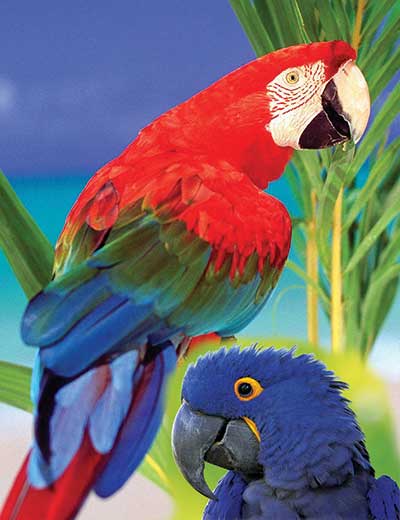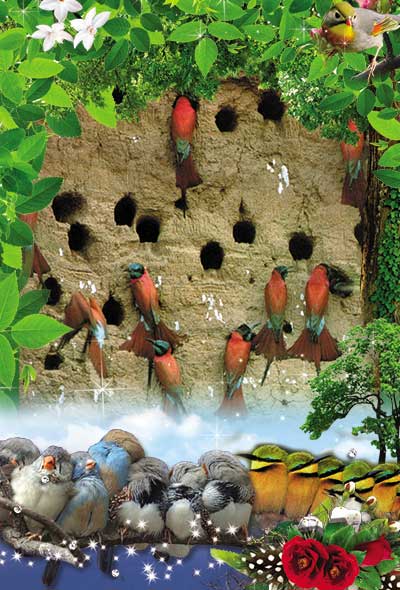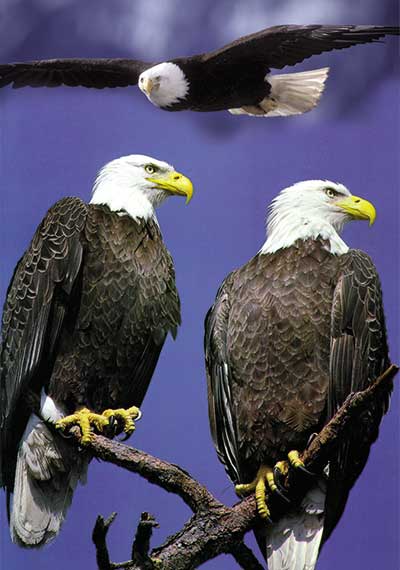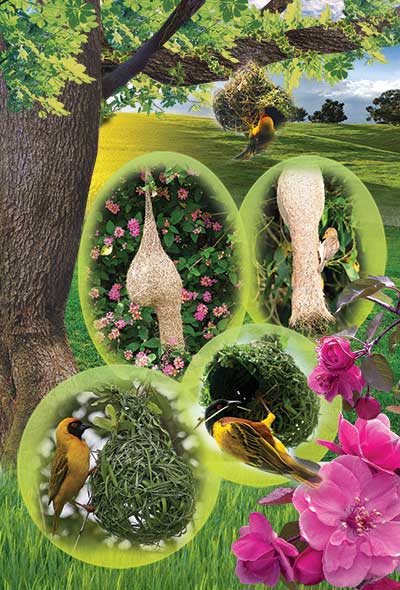 |
When a person is infected with poison, his only recourse is to take a drug to counter the effects of the poison or to remove the poison from his body through medical intervention. Otherwise, a person who lacks specialized knowledge about poisons will be unable to cure himself through using a plant or some other kind of counteractive substance.
Yet, some creatures innately have this knowledge that most people must learn through education. Certain animals, which do not possess minds to be educated, any intelligence and, in short, any consciousness at all, can cure themselves very easily. The striking feature about the methods animals use to cure themselves is that they know what to do very well and have determined what is good for each particular illness. Is it really the animals themselves who have determined these things? How have animals come to possess such knowledge? Evolutionists claim that most animal behavior such as this is instinctive. However, they cannot explain the origin of these behaviors or how they originally came to exist.
First of all, it is not possible for creatures to learn these behaviors over time. An animal that is poisoned, for example, will die right away. In this case, it is not possible for it to imagine how it might remove the factor that caused it to be poisoned. Besides, we should by no means forget that animals lack the consciousness capable of thinking up such a solution.
Let us see, by giving an example, how animals display conscious behavior while curing themselves. Macaws, which are a kind of parrot, are found in the tropical regions of Central and South America. One of the most striking feature of these creatures, besides their truly dazzling colors, is that they feed on poisonous seeds. These birds, who can break even very tough shells with their hooked beaks, are experts on the subject of poisonous seeds. This is a somewhat surprising situation because, when the bird eats a poisonous seed, normally it should suffer harm. Yet, amazingly, this does not happen. Immediately after the bird eats the poisonous seeds, it flies directly towards a rocky place and begins to gnaw and swallow the clayey rock pieces there. The reason for this behavior is that the clayey rock pieces absorb the toxins in the seeds, and so neutralize the effects of the poison. In this way, the birds can digest the seeds without experiencing any harm.28
It is certainly impossible for macaws to know on their own how to neutralize or counteract the poison found in the seeds they eat. It is evident that such conscious behaviors in creatures do not originate from themselves, and that their origin cannot be sought in some other force or factor that exists in nature either. An invisible power controls the behavior of all creatures and, in other words, inspires them with what to do. This matchless power belongs to Allah. Allah, Who is the owner of a superior knowledge, is the Preserver of all things.
 |
Although it seems impossible, some birds can even dig through stones. The only instrument they use while breaking into hard stones is their beaks. The bee-eater is one these birds.
The bee-eater makes its nest on the surface of sandstone cliffs or by constantly hitting its beak on rough mud and making holes along the riverside. It continues to excavate until the hole becomes a narrow tunnel stretching 90-100 cm (3 feet) long. The short, strong claws of the bee-eater also help this digging work to open the sides of the nest. It pours out the deposited soil particles with the help of its claws. Several species of these bee-eaters live in colonies made up of 1,000 or more birds. Scientists are at a loss for an explanation as to how each bird locates its own nest among these mass, teeming colonies.29
Another interesting characteristic of bee-eaters is their specialization in bug hunting. These birds feed on bees. This is somewhat surprising because it could be fatal for other birds to eat bees. However, the bee-eaters are not affected at all by the bees' venom. These birds first rub the hunted bee's abdomen against a branch of a tree and wear it away. Thus, its venom is discharged harmlessly into the air.30
The other body features of bee-eaters are also suitable for making catching the insects easy. For example, it has a beak 4.5 cm (1.8 inches) long. This length is important since, if this bird's beak were shorter, the insects could harm it while it tried to hunt. In addition, the sharp tip of its beak enables it to catch its prey from the part between the chest and stomach. In this way it can empty the bee's venom more easily
Certainly, a bird's knowledge of how to deactivate the poison of an insect is not a behavior that he can learn and perform on its own. No one can claim that the bird might have discovered such a solution and risking fatal danger in the process by the trial-and-error method. A bird's employment of such rational tactics shows that it was born onto this Earth with this piece of knowledge innately acquired. Moreover, the fact that all the bird's bodily features have a structure ideally suited for the hunting process is an evident indicator that this creature was created in a way that enables it to hunt bees. Bee-eaters, like all other living things on Earth, have been created along with their existing features by Allah.
Behold! in the creation of the heavens and the earth; in the alternation of the night and the day; in the sailing of the ships through the ocean for the profit of mankind; in the rain which Allah Sends down from the skies, and the life which He gives therewith to an earth that is dead; in the beasts of all kinds that He scatters through the earth; in the change of the winds, and the clouds which they Trail like their slaves between the sky and the earth;- (Here) indeed are Signs for a people that are wise. (Surah Al-Baqara, 164)
 |
When we examine birds, we see that all the features of their bodies have been designed especially for flying. For example, the body structure of eagles, which are known as one of the birds with the best capabilities for movement, is perfect in every way. The eagle needs to be both light enough to be able to take off from anywhere easily and strong enough to carry its prey after catching it. A bald eagle has more than 7,000 feathers. However, when you put all these feathers together, they weigh only approximately 500 gr. (18 ounces). In addition, in order to provide a lighter body weight, the insides of the bones are hollow. In many parts of these bones there is nothing but air. The total weight of a bald eagle tips just over 272 gr. (9.5 ounces). In short, the body weight of the eagle is ideal for flying.
An eagle derives the force it needs for flying from the downward flapping movements of its wings. For this reason, the number of its muscles that push the wings downwards is greater than the number of the muscles that push them upwards. Flight muscles are very important for an eagle.
These muscles generally weigh half of the bird's total body weight. The eagle can fly faster or slower by changing the position of its wings. When the eagle wants to fly faster, it turns the front sides of the wings inwards towards the wind and thus slices through the air. When it wants to go slower, it turns the wide sides of its wings against the wind.
All the eagles have an extra eyelid called a "nictitating membrane." The function of this special lid is to clean and protect the eyes of the birds. For example, eagles usually pull the membranes over their eyes when feeding their chicks. It is a precaution to protect the eyes of the parents from any harm that these chicks might accidentally inflict as they lunge for food. 31
The design of the eagle concerns not only a flawless flight technique, but also a special design in its feathers for landing. As the eagle starts to go down, it decreases its speed by pulling its tail down at an angle to its body. It lowers the edges of its wings so as to use them as brakes. But, as the eagle loses speed, turbulence formed on the upper surface of the wings increases its danger of stalling. The eagle counters this danger by raising the tufts of three or four feathers that are found on the edge of its wings. These let in a stream of air across the wing surface, which maintains a smooth flow, and enable the bird to easily complete its flight.32
There is an evident fact in the examples given so far. Even a mere couple of details in the design of an eagle's body are so perfect that they couldn't have come into existence by chance. This clearly proves to us that eagles also, like all other birds and creatures, have been created by Allah, the All-Powerful.
 |
Is it possible to say that a creature which builds strong nests made up of interlocked plaits on twigs using very systematic movements, cutting long, thin strips out of fresh, green leaves, has "learned to do this through chance"? Certainly, the claim of "learning by chance" would be a somewhat insufficient explanation for such skills. As you will see in the example we are about to give, many features present in animals openly expose how irrational and unreasonable are the claims of the evolutionists.
The weaver bird first collects the material it will use. The bird either cuts long, thin strips out of fresh, green leaves or it makes use of the middle vein of the leaves. Surely, it has a reason for using these fresh leaves. It would be difficult for the bird to handle material from dry leaves and to use them in weaving, whereas such processes are carried out very easily with fresh leaf fibers. The bird begins the work by first of all wrapping the end of a long strip, torn from a leaf, around a twig. Holding one end of the strip against the twig with one foot, it works the other end with its beak.
In order to prevent the fibers from falling down, it attaches them together by tying a knot. First, the bird makes a loop. This is the entrance to its nest. Then, using its beak like a shuttle, it passes the leaf fibers over and under the other fibers in an orderly way. The bird must calculate how taut it should pull each strip during the process of weaving because, if the weaving is loose, the nest will collapse away. In addition, it must envisage the final shape of the nest so it can decide when the walls of the nest should be curved or be given an outward-projecting shape.
After weaving the entrance, the bird begins to weave the walls of the nest. To do this, it hangs downwards and continues to work from inside the nest. With its beak, it pushes one fiber under another and then holds the free end of fiber and pulls it tightly. Thus, very orderly weaving is formed.33
As noted above, the weaverbird always works by following certain steps while building its nest. First, it collects the most appropriate material for the nest. It does not begin to weave its nest from a randomly chosen point but first makes an entrance and continues to build the walls from there. It is certainly impossible to claim that the weaverbirds have acquired these skills by unconscious coincidences. The fact that the weaverbirds also, like all other creatures, act through the inspiration of Allah is an evident fact that every man of reason and consciousness can easily see.